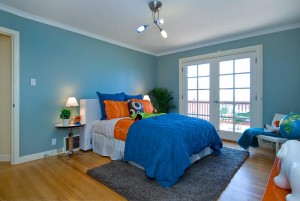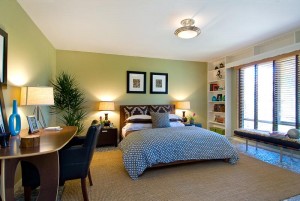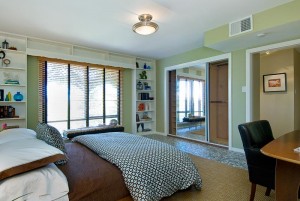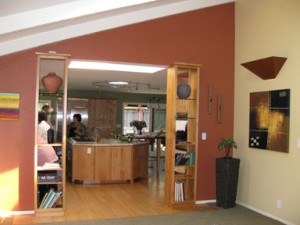Selecting Wall Colours – Some Tips
I am one of the lucky ones. I can visualize the finished look of a room and I have an instinct for what works well together. I suppose that’s why I do what I do. We all have our special skills, and I suppose this one is mine. But with a few basic tips you too can be on the road to having colour throughout your home.
WHITES – If you have visited a paint store recently you know that not all whites are alike and that there is a staggering variety to choose from. White will take on the colours of the environment and therefore it is very important to pick the right white. For example, in rooms with lots of beige or taupe, you must use a very bright, pure white. Any white with cream or yellow undertones will look dirty against the beiges. Alternatively, if you have warm colours in the room, either other paint colours or in your furnishings, a bright white will be too harsh. Here you would opt for a softer white, with a very slight yellow undertone. These rules apply for ceilings as well.
TRIM – White is still the preferred choice for door and window frames, crown mouldings and baseboards. Use the brightest, richest white, while staying within your preferred shade, either a pure, clean white, or a softer tone. And always use a semi-gloss finish. The gloss paints are not only easier to clean, but because they reflect light, the trims are highlighted in a very appealing way. Just be sure that they are well sanded and any imperfections corrected before painting as gloss paints also highlight all the faults! And all trim throughout the house should be the same colour to create a pleasing flow from one space to the next.
DOORS – There is no set rule on what colour to paint your doors. Some people prefer them to match the trim and the same throughout the house. Others prefer the door to match the wall colour, which means you may have a different colour on either side of the door. This is personal preference and I vary my decision based on the rest of the colours and where they are used in a room. For example, if I have painted an accent wall red, then a door on that wall might also be red, though the trim is white. This assures that the door is not a big distracting block of white. But if the whole room is painted red, then the white door is exactly what I need to brighten up the room and set off the red walls. Another example, and often a point of confusion, is what to do with the doors that open onto a long hallway, particularly if the hallway is not white. The only rule here is, whatever colour is selected, all the doors on the hallway side be painted the same colour.
COLOUR – Yes, it can be scary to move out of the white and beige comfort zones. But bringing colourful walls into your home is the easiest, and least expensive way to make a big impact on your interior design. I will touch on this more in a future posting on colour theory, how different colours make us feel and how they work in a room. But first, think about what colours you love, because these are the ones you can live with, and in. Give some thought to other colours in the room, but because of the huge choice in shades of a colour, you can always find something that will work. Using the example of the red walls again, the shade you select can vary from the cool pink and magenta reds, through to the bright lipstick reds, move onto the deep jewel tones, and finally to the soft and warm rust and terra cotta tones. Each of these will interact differently with other colours. But rest assured that if you want red, there is a shade out there that will work perfectly for you!
ACCENT WALLS – The safest way to experiment with strong colours is to create a feature wall, which is one wall in a room that is painted a different, darker colour. Feature walls work well placed opposite an entry, but the more important consideration is the orientation of the room and what will be against the feature wall, so it can work as a backdrop or a frame. In a lounge, this might be the wall where the TV and entertainment center sits, or the wall around the fireplace surround. If you have a very large window or glass door, this could be the accent wall, with the window or door frames trimmed in white, and the colour framing the glass and the outlook beyond. In a bedroom, the accent wall could be the one your bed is placed against.
CEILINGS – Here is the hardest design trick of all, what to do with the ceiling! This subject alone could take up an entire article, with lots and lots of varying opinions. The standard then, both easiest and safest, is to stick with white. I like to use the same white on the ceiling as is used throughout for the trims. But always, always use flat paint! Do not let anyone convince you otherwise. Because lights are either in the ceiling, or reflect up to the ceiling, any other finish but the flattest flat paint will show up every tiny fault and mark. Except for one very important exception to both rules – bathrooms. I always have the ceilings of a bathroom painted in the same colour as the walls. This a great trick for making a small room look bigger. Even if the walls are dark, that dark ceiling, contrary to popular belief, will expand the space. And in a bathroom, the ceiling paint should always be semi-gloss, just like the walls. This will go a long way towards protecting the finish and cutting down on mould.
ROOM TO ROOM – The open plan way we live today means that when you are choosing new colours for a room, you must also consider how they will work with colours in other rooms that open onto each other. If you want to repaint the dining room red, but your lounge is green, this is an important consideration. Not all reds go with all greens, and more important to decide is if you want to see these colours together, as you may depending where they are in relation to each other. You may need to change the shade of red, select a different colour, or also repaint the lounge.
TESTING COLOURS – Working with paint chips, narrow down your choices to three shade of each colour. Then, do not paint patches on your walls! I always cringe when I see this because it doesn’t work. The only time it might is if you are testing feature wall colours on the feature wall itself. Instead, get yourself a few pieces of good sized, heavy white board, such as foamboard or posterboard. Buy paint in the colours you have selected, hopefully these will be available in small test pots. Paint the boards as you would the wall: primer is not necessary, but be sure to do one coat, let it dry, then a second. Once the boards are ready, you can now move them around the room. Using boards this way you can see your colours in different light, on different walls, and up against other colours in the room. And you can move them from room to room. You can also assess each colour on it’s own without a lot of other patches to distract you. A much better way.
The last thing to remember is that if you don’t like it, you can always change it! Happy painting!





